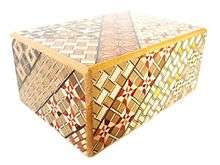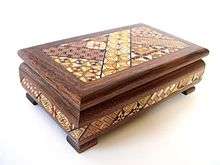Yosegi


Yosegi-zaiku (寄木細工) is a type of traditional Japanese parquetry which originated during Japan’s culturally rich Edo Period. It has been increasingly well reputed in foreign countries. The mosaic work is made by making use of natural fine grains and textures of wood. Timbers of different colors are cut into oblong rods of desired sections. Spindle tree (Euonymus spp.) and Ilex macropoda are used for white, aged Katsura tree (Cercidiphyllum japonicum) for black, Picrasma quassioides, mulberry (Morus alba) and Chinese lacquer tree (Toxicodendron vernicifluum) for yellow, camphor tree (Cinnamomum camphora) and Maackia for brown, black walnut (Juglans nigra) for purple, Japanese cucumber tree (Magnolia obovata) for blue and Chinese cedar (Toona sinensis) for red. The rods are then glued together to form the section of geometrical design pattern. The sectional surface is sliced into thin plates of wood, which are glued onto boxes and other handicraft works. To add to the glaze and sturdiness of the surface, finishing coatings of lacquer are applied.
Yosegi are commonly found on the outside of Japanese secret boxes or puzzle boxes, but may also be used to create or decorate many other items such as trays, chests, jewellery boxes, vases, photo frames, drink coasters, etc.
The Yosegi puzzle boxes differ in sizes and number of moves required to open them. The physical length is usually measured in the traditional Japanese units of measurement called the sun, with one sun equal to approximately 3 centimetres (1.2 in), hence a "5 sun" box would measure about 15 centimetres (5.9 in) in length. Boxes are most typically between 3 and 6 sun in length. Some well-known masters pride themselves in making unique boxes that do not follow any size guidelines.
See also
External links
- Collection Ruth und Clemens Stupperich Yosegi - collection (catalogue)